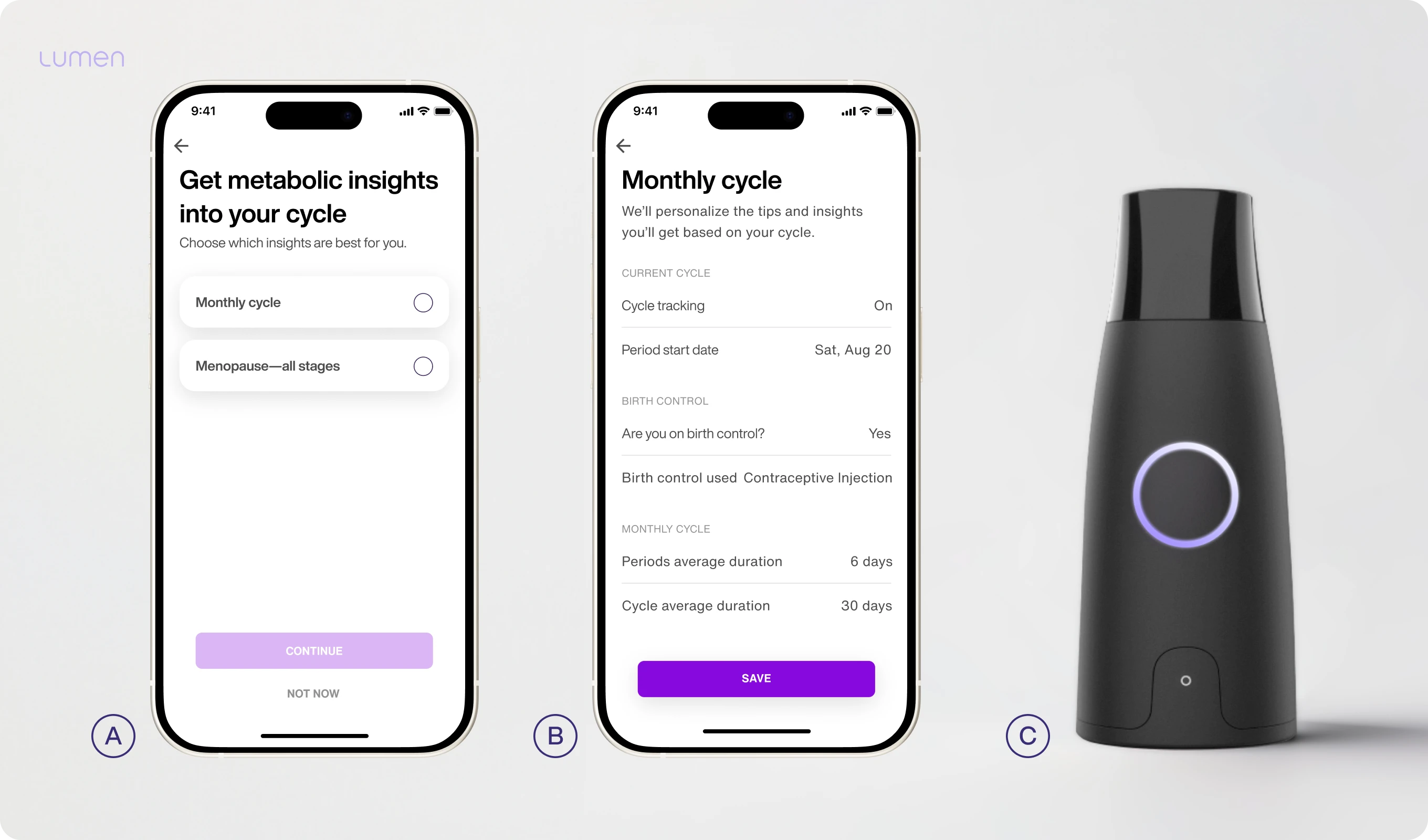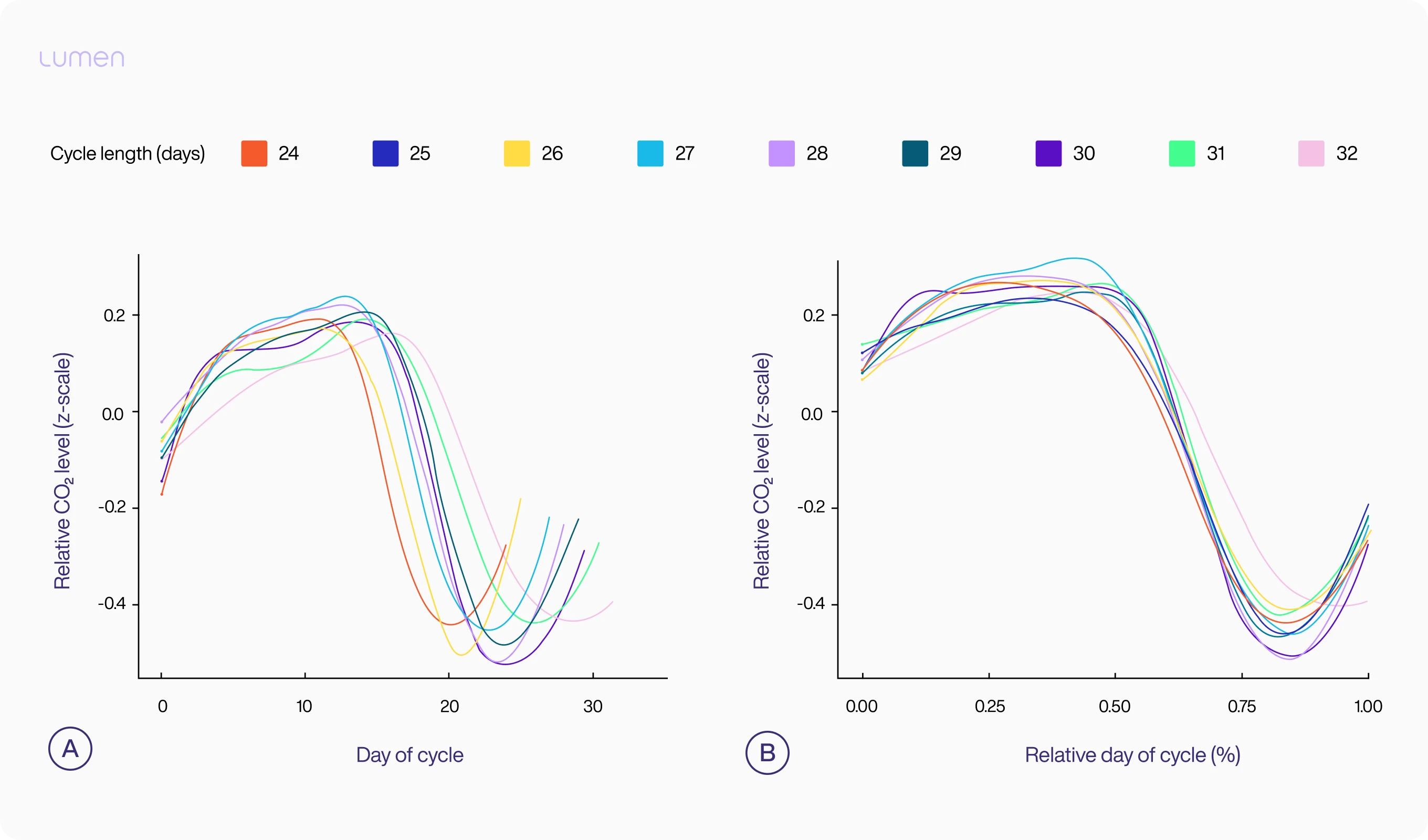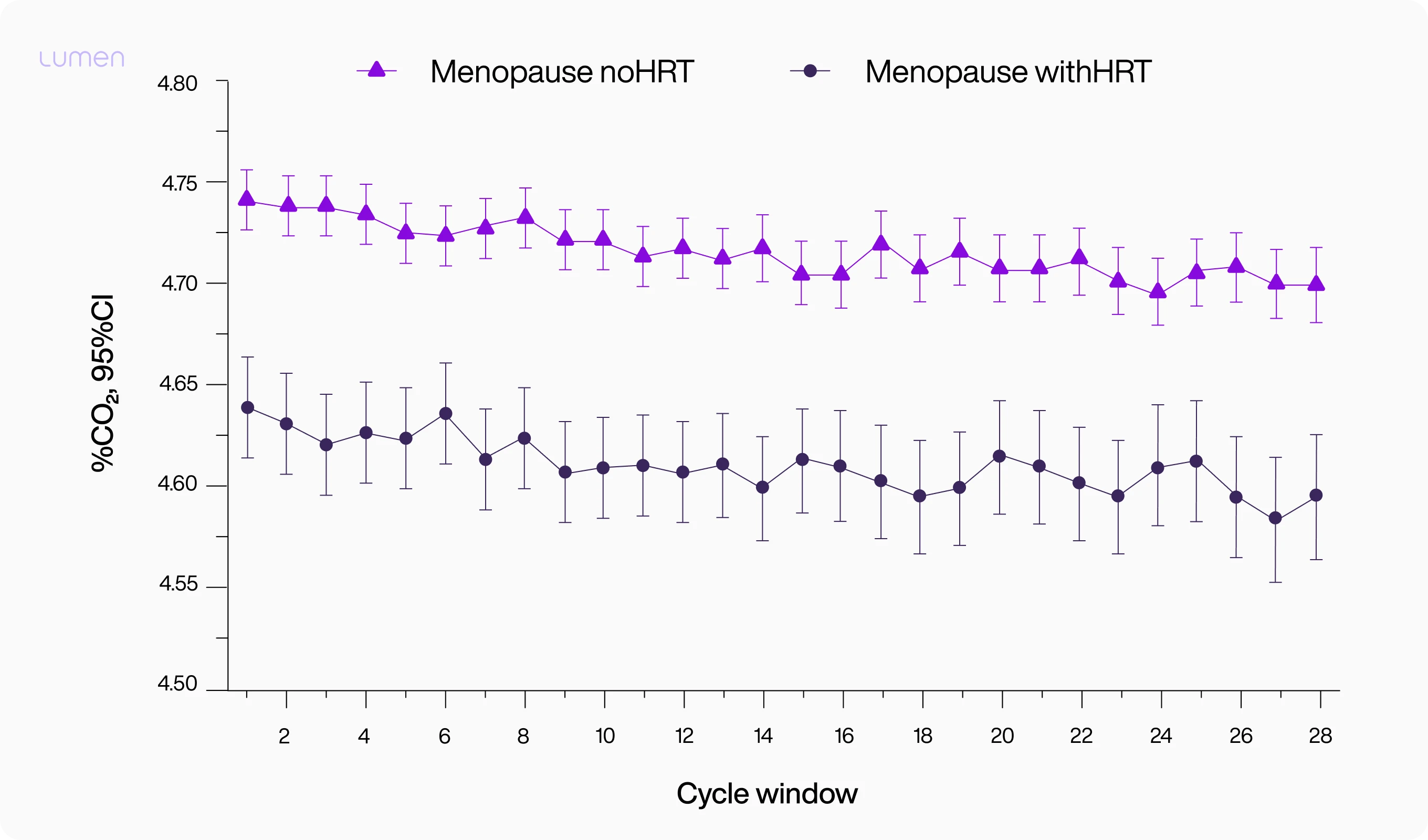Women’s hormonal shifts are inextricably linked to metabolism


Women make up 49.7% of the global population. Yet, there’s a lack of adequate research that supports their unique health challenges. This gap in women’s healthcare overlooks the role of biological sex [1] in physiological, metabolic, and hormonal differences and how they impact the way diseases present, as well as the effectiveness of pharmaceuticals and medical devices.
Lumen’s latest research study, published in Digital Biomarkers, set out to provide deeper insights into the unique metabolic fluctuations experienced by women, potentially enabling tailored care and lifestyle interventions.
New findings from Lumen’s peer-reviewed retrospective analysis of metabolic measurements taken by 3,981 Lumen users revealed distinct patterns of exhaled carbon dioxide (CO₂) across monthly cycle phases and among menopausal women with and without HRT [2].
 Screenshot from the onboarding process of the Lumen app. All users provided their personal information regarding age, gender, height, and weight. Additionally, users were requested to specify whether they are menopausal or menstruating (a) and whether they are using HRT or HBC and indicate their monthly cycle start date (b). Illustration of the Lumen device (c).
Screenshot from the onboarding process of the Lumen app. All users provided their personal information regarding age, gender, height, and weight. Additionally, users were requested to specify whether they are menopausal or menstruating (a) and whether they are using HRT or HBC and indicate their monthly cycle start date (b). Illustration of the Lumen device (c).
Many of the symptoms women experience at various stages of the monthly cycle and the onset of menopause can be traced back to the influence that hormonal changes have on metabolism. CO₂ monitoring has emerged as a useful tool for the monthly cycle and understanding metabolic changes during menopause.
The menstrual cycle is a complex physiological process regulated by several sex hormones, and changes in these hormones have been found to affect women’s metabolism [3,4]. CO₂ is a fundamental marker of metabolic activity in the human body and provides valuable insights into physiological processes [5].
The Lumen study identified a distinct rhythmic pattern of CO₂ levels during the different phases of the menstrual cycle. CO₂ levels were significantly higher during the follicular phase leading up to ovulation, indicating more carb burn; whereas CO₂ was lower in the luteal phase, pointing to increased fat burn.

CO₂ changes of different monthly cycle lengths. Cycle lengths were determined according to the calculated duration between each menstruation starting day of two consecutive cycles. (a) Time is displayed on a day of cycle scale, as reported by the participants. (b) Relative time-scale in percentages, calculated for each cycle length of each participant, indicating the overall pattern is consistent for all cycle lengths.
Understanding the timing and progression of different stages within the monthly cycle is crucial for women’s health and reproductive physiology [6]. Accurate identification and tracking of these stages are essential for fertility management and the diagnosis and treatment of menstrual disorders. It also provides essential information for making nutrition and exercise choices that better support the body during various phases of the monthly cycle.
Menopausal women undergo hormonal changes, such as decreased progesterone levels. Lumen’s study indicated higher CO₂ levels for menopausal women not using HRT, compared to those with HRT, suggesting an association with progesterone changes. This underscores the need for further research investigating the potential implications of progesterone fluctuations in CO₂ for menopausal women.
 Averaged daily CO₂ measurements of the two menopausal groups. Data drafted over a 28-day moving window of accumulated measurements per day.
Averaged daily CO₂ measurements of the two menopausal groups. Data drafted over a 28-day moving window of accumulated measurements per day.
The first finding aligns with the fact that the transition from pre- to postmenopause is commonly linked to the emergence of many features of metabolic syndrome, such as central obesity, insulin resistance, and high blood lipid levels [7,8].
It also presents an opportunity for these women to track and measure their metabolism and improve their quality of life with lifestyle recommendations around nutrition, exercise, sleep, and stress management to overcome common menopausal symptoms.
The second finding about HRT can help healthcare professionals close the care gap by tailoring hormonal treatment plans to address individual metabolic needs and mitigate body composition and health issues brought on by menopause. It also supports women tracking their metabolism to understand the impact of treatment.
The correlation between metabolic changes and hormonal fluctuations opens new avenues for personalized health strategies. By leveraging such insights, healthcare providers can offer more tailored advice that aligns with the natural rhythms of a woman’s body. This means that in many cases, we can address symptoms and improve care and quailty of life for women with interventions aimed at supporting metabolism and metabolic flexibility.
[1] Miguel-Aliaga, I. (2022). Let’s talk about (biological) sex. Nature Reviews Molecular Cell Biology, 23(4), 227–228. https://doi.org/10.1038/s41580-022-00467-w
[2] Cramer, T., Yeshurun, S., & Mor, M. (2024). Changes in Exhaled Carbon Dioxide during the Menstrual Cycle and Menopause. Digital biomarkers, 8(1), 102–110. https://doi.org/10.1159/000539126
[3] Draper, C. F., Duisters, K., Weger, B., Chakrabarti, A., Harms, A. C., Brennan, L., Hankemeier, T., Goulet, L., Konz, T., Martin, F. P., Moco, S., & van der Greef, J. (2018). Menstrual cycle rhythmicity: Metabolic Patterns in healthy women. Scientific Reports, 8(1). https://doi.org/10.1038/s41598-018-32647-0
[4] Benton, M. J., Hutchins, A. M., & Dawes, J. J. (2020). Effect of menstrual cycle on resting metabolism: A systematic review and meta-analysis. PLOS ONE, 15(7). https://doi.org/10.1371/journal.pone.0236025
[5] Livesey, G., & Elia, M. (1988). Estimation of energy expenditure, net carbohydrate utilization, and net fat oxidation and synthesis by indirect calorimetry: Evaluation of errors with special reference to the detailed composition of fuels. The American Journal of Clinical Nutrition, 47(4), 608–628. https://doi.org/10.1093/ajcn/47.4.608
[6]Rogan, M. M., & Black, K. E. (2022). Dietary energy intake across the menstrual cycle: A narrative review. Nutrition Reviews, 81(7), 869–886. https://doi.org/10.1093/nutrit/nuac094
[7] Carr M. C. (2003). The emergence of the metabolic syndrome with menopause. The Journal of clinical endocrinology and metabolism, 88(6), 2404–2411. https://doi.org/10.1210/jc.2003-030242
[8] Polotsky, H. N., & Polotsky, A. J. (2010). Metabolic implications of menopause. Seminars in reproductive medicine, 28(5), 426–434. https://doi.org/10.1055/s-0030-1262902

Our Lumen editorial desk includes an in-house team of certified and registered nutritionists and dietitians, scientists, researchers, and writers.